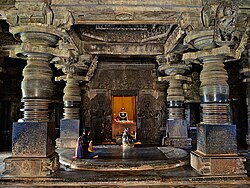หเลพีฑู
หเลพีฑู หรือ หเลพีฑ (IAST: Haḷēbīḍ, นิยมสะกด Halebidu; แปลตรงตัว: "ราชธานีเดิม"[1], "นครที่เป็นซาก"[2]) เป็นเมืองในอำเภอฮัสซาน รัฐกรณาฏกะ ประเทศอินเดีย หรือชื่อเดิม โทรสมุทร หรือ ทวารสมุทร ซึ่งเป็นชื่อตั้งแต่ในศตวรรษที่ 11 เมื่อเป็นราชธานีของจักรวรรดิโหยสฬะ[3][note 1] หเลพีฑูกลายมาเป็นชื่อที่คนในท้องถิ่นเรียกเมืองหลังรัฐสุลตานเดลีเข้าโจมตีและทำลายทวารสมุทรในศตวรรษที่ 14[4][5][6]
หเลพีฑู โทรสมุทระ หรือ ทวารสมุทระ | |
|---|---|
town | |
 | |
| พิกัด: 13°12′57″N 75°59′29″E / 13.2157°N 75.9914°E | |
| ประเทศ | อินเดีย |
| รัฐ | รัฐกรณาฏกะ |
| อำเภอ | ฮัสซาน |
| ความสูง | 880 เมตร (2,890 ฟุต) |
| ประชากร (2001) | |
| • ทั้งหมด | 8,962 คน |
| เขตเวลา | UTC+5:30 (IST) |
| รหัสโทรศัพท์ | 08172 |
| เว็บไซต์ | karnataka |
หเลพีฑูเป็นที่ตั้งของตัวอย่างชิ้นสำคัญของสถาปัตยกรรมโหยสฬะ ทั้งที่เป็นเทวสถานของฮินดูและไชนมนเทียร ในบรรดาเทวสถานของโหยสฬะทั้งหมดในเมืองมีแหล่งที่สำคัญคือโหยสเฬศวรมนเทียร[7][8][9]
หมายเหตุ แก้
- ↑ Dorasamudra was one of the capitals of the Hoysalas. Governors had their own capital, with temples and infrastructure. Sosavur (Sasapura, Sasakapura) was their first capital. Belur served as another capital for a part of the 12th-century. The king used to relocate and stay for extended periods in other capitals. However, Dorasamudra is repeatedly called as the srimad rajdhani ("most illustrious capital") in inscriptions found in distant parts of the Hoysala kingdom.
อ้างอิง แก้
- ↑ JF Fleet, Nele-Vidu: Appayana-Vidu, The Journal of the Royal Asiatic Society of Great Britain and Ireland, Cambridge University Press, pp. 117-119, JSTOR 25189510
- ↑ Duraiswamy, S. (2004). The Creative Touches of the Chisel. p. 107. ISBN 978-955-8095-49-2.
- ↑ Katherine E. Kasdorf (2013), Forming Dōrasamudra: Temples of the Hoysaḷa Capital in Context, Columbia University Press, pp. 44–46
- ↑ Robert Bradnock; Roma Bradnock (2000). India Handbook. McGraw-Hill. p. 959. ISBN 978-0-658-01151-1.
- ↑ Catherine B. Asher (1995). India 2001: Reference Encyclopedia. South Asia. pp. 29–30. ISBN 978-0-945921-42-4.
- ↑ Joan-Pau Rubiés (2002). Travel and Ethnology in the Renaissance: South India Through European Eyes, 1250-1625. Cambridge University Press. pp. 13–15. ISBN 978-0-521-52613-5.
- ↑ V Bharne; K Krusche (2014). Rediscovering the Hindu Temple: The Sacred Architecture and Urbanism of India. Cambridge Scholars Publishing. pp. 1–17. ISBN 978-1-4438-6734-4.[ลิงก์เสีย]
- ↑ "Adinatha Basti, Halebid | ASI Bengaluru Circle". คลังข้อมูลเก่าเก็บจากแหล่งเดิมเมื่อ 2016-04-18. สืบค้นเมื่อ 2021-09-24.
- ↑ Gopal, Madan (1990). K.S. Gautam (บ.ก.). India through the ages. Publication Division, Ministry of Information and Broadcasting, Government of India. p. 178.
แหล่งข้อมูลอื่น แก้
วิกิมีเดียคอมมอนส์มีสื่อที่เกี่ยวข้องกับ หเลพีฑู
- Sacred Ensembles of the Hoysala – Belur and Halebid, UNESCO World Heritage Sites Pending Application Package
- Hoysalesvara Temple, Halebid เก็บถาวร 2021-08-26 ที่ เวย์แบ็กแมชชีน, Archaeological Survey of India, Bengaluru Circle
- Parsvanatha Basadi, Halebid เก็บถาวร 2017-11-18 ที่ เวย์แบ็กแมชชีน, Archaeological Survey of India, Bengaluru Circle
- Kedaresvara Temple, Halebid เก็บถาวร 2021-08-26 ที่ เวย์แบ็กแมชชีน, Archaeological Survey of India, Bengaluru Circle
- Shantinatha Basadi, Halebid เก็บถาวร 2016-11-28 ที่ เวย์แบ็กแมชชีน, Archaeological Survey of India, Bengaluru Circle
- Step well, Hulikere Halebid เก็บถาวร 2021-08-26 ที่ เวย์แบ็กแมชชีน, Archaeological Survey of India, Bengaluru Circle

